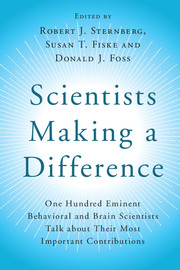 Scientists Making a Difference
Scientists Making a Difference Book contents
- Frontmatter
- Contents
- List of Contributors
- Foreword: Making a Creative Difference = Person × Environment
- Preface
- Part I Introduction
- Part II Biological Bases of Psychology: Genes, Brain, and Beyond
- Section A Feelings, Fears, Stressors, and Coping
- Section B Cognitive and Social Neuroscience
- 9 Social Neuroscience
- 10 Modulating Memory Consolidation
- 11 Memory Consolidation and Transformation: The Hippocampus and Mental Time Travel
- 12 Imaging the Human Brain
- 13 Different Mechanisms of Cognitive Flexibility Within the Prefrontal Cortex
- 14 Memory and Brain
- Section C Behavioral and Molecular Genetics
- Part III Cognition: Getting Information from the World and Dealing with It
- Part IV Development: How We Change Over Time
- Part V Motivation and Emotion: How We Feel and What We Do
- Part VI Social and Personality Processes: Who We Are and How We Interact
- Part VII Clinical and Health Psychology: Making Lives Better
- Part VIII Conclusion
- Afterword: Doing Psychology 24×7 and Why It Matters
- Index
- References
9 - Social Neuroscience
from Section B - Cognitive and Social Neuroscience
Published online by Cambridge University Press: 05 August 2016
- Frontmatter
- Contents
- List of Contributors
- Foreword: Making a Creative Difference = Person × Environment
- Preface
- Part I Introduction
- Part II Biological Bases of Psychology: Genes, Brain, and Beyond
- Section A Feelings, Fears, Stressors, and Coping
- Section B Cognitive and Social Neuroscience
- 9 Social Neuroscience
- 10 Modulating Memory Consolidation
- 11 Memory Consolidation and Transformation: The Hippocampus and Mental Time Travel
- 12 Imaging the Human Brain
- 13 Different Mechanisms of Cognitive Flexibility Within the Prefrontal Cortex
- 14 Memory and Brain
- Section C Behavioral and Molecular Genetics
- Part III Cognition: Getting Information from the World and Dealing with It
- Part IV Development: How We Change Over Time
- Part V Motivation and Emotion: How We Feel and What We Do
- Part VI Social and Personality Processes: Who We Are and How We Interact
- Part VII Clinical and Health Psychology: Making Lives Better
- Part VIII Conclusion
- Afterword: Doing Psychology 24×7 and Why It Matters
- Index
- References
Summary
Social species by definition create organizations and processes beyond the individual. These superorganismal structures and processes can differ across species, but typically evolved hand in hand with neural, hormonal, cellular, and genetic mechanisms because the consequent structures and behaviors helped these organisms survive, reproduce, and leave a genetic legacy. Humans, born to a long period of utter dependency and dependent on conspecifics across the lifespan to survive and prosper, are an ultra-social species. Attachment, attraction, attitudes, aggression, altruism, affiliation, attribution, conformity, contagion, cooperation, competition, communication, culture, and empathy are just a few behavioral processes that are fundamentally social.
I attended graduate school at Ohio State University, where I studied both social and biological approaches to behavior. When I proposed a dissertation that sought to bring these perspectives together to better understand the factors and mechanisms underlying social behavior, however, I received pushback from both sides. From the biological perspective, social factors were thought to be a recent evolutionary development, and therefore to have few (if any) implications for the basic development, structure, or function of the nervous system. And even if they did, the notion was that they were too complex to study effectively in our lifespan. From the social perspective, the twentieth century had seen two world wars, a great depression, generations of social injustice, and the development of nuclear warfare. Even if the brain and biology were relevant, the pushback was that it would take far too long to develop a sufficient understanding of the brain to contribute anything to our understanding of social processes or behavior, much less to the solution of the social ills that threatened society.
If not for the encouragement of my roommate – a fellow graduate student and now life-long friend, Richard Petty – to pursue my passion, my career might have taken a very different course. And if not for the good fortune of joining the faculty at Ohio State University in 1989 in both social psychology and biopsychology, and striking up a collaboration with yet another great friend and colleague, Gary Berntson, we likely would never have proposed the interdisciplinary field of social neuroscience with the goal of identifying the neural, hormonal, cellular, and genetic mechanisms underlying social structures and processes, and identifying the specific influences and pathways linking social and neural structures and processes.
- Type
- Chapter
- Information
- Scientists Making a DifferenceOne Hundred Eminent Behavioral and Brain Scientists Talk about Their Most Important Contributions, pp. 45 - 48Publisher: Cambridge University PressPrint publication year: 2016


